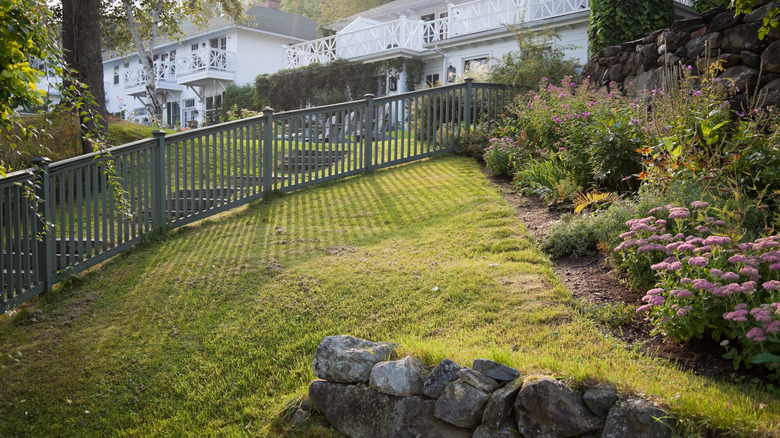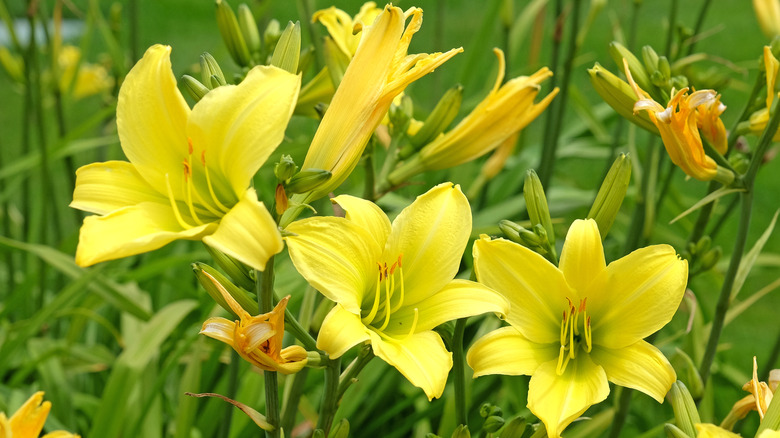The Fast-Growing Yellow Flower That Doubles As A Ground Cover In Sloped Yards
Looking for an eye-catching flower to plant in your yard? Daylilies (Hemerocallis) are one fast-growing option that can beautify any lawn or garden. With its tuberous roots that bind easily to soil, this eye-catching perennial is simple to plant, thrives in Hardiness Zones 3 through 9, and can even do double-duty as a ground cover in sloped parts of your yard. "Daylilies multiply and form dense clumps relatively quickly, especially when spaced 12 to 18 inches apart," plant expert Linda Vater shared in a Martha Stewart article. "After a few years, they can be divided and used to fill in other areas of the landscape."
Depending on their exact variation, daylilies flower during the spring, summer, or fall, bursting into bright yellow, orange, pink, red, or white blossoms. As the name suggests, each flower only lasts a day, but these plants are so densely covered with buds that they rarely look sparse. This plant is beloved for its look and durability — once they've been planted and established, daylilies require very little care to thrive. They also draw butterflies and hummingbirds, adding to their aesthetic appeal. However, there are some potential drawbacks to keep in mind. Daylilies aren't native to the United States, and they spread so quickly that they can take over your yard or garden.
How to plant and care for daylilies
Some variations of daylilies, such as the electric-orange tawny daylilies (Hemerocallis fulva), are considered invasive plants you should never grow in many regions of the country. If you commit to planting daylilies, be sure to research whether they're considered invasive in your area and how to keep their spread under control. Avoid planting them near any shrubs that they'll need to compete with for water. Spring or early fall are generally the best time to plant daylilies — that's when soil is softer and easiest to work with. Once you've decided on a timeframe, choose a patch of your yard or garden that gets plenty of sunshine. Though this plant can withstand a variety of terrains, including ditches or awkward, sloping areas, they fare best in full sun. Then, proceed as you would with any plant, following applicable instructions and being sure to cover the tubers in holes that are about 1 inch deep. Water your daylilies about once a week until they sprout.
As far as annual maintenance goes, there really isn't much to it. Again, daylilies are hardy, salt-resistant, and rarely suffer diseases. It's a big reason why they're such a popular pick among gardeners. You don't have to be too precious with them or worry about fertilizing their soil; however, it's a good idea to remove any dead foliage from your daylily patch at the start of spring to make space for new growth.
Less-aggressive alternatives to daylilies that still offer ground cover
Despite their resilience, aesthetic appeal, and ability to function as a ground cover, daylilies aren't the right pick for everyone who wants ground cover in their yard. For one thing, even non-invasive variations of this plant can grow aggressively fast and block out light or nutrients from other plants. Since they thrive in full sun, daylilies aren't suitable for areas that are heavily shaded. This plant is toxic to cats — if your fuzzy friend spends time outside in your lawn or garden, you may want to avoid planting them. They're also deer magnets and can easily get damaged if you live in a wooded area with a large deer population.
Shade-loving green and gold (Chrysogonum virginianum) is another pretty flower that's a less-aggressive alternative to daylilies. This native plant is deer-resistant, does well in partial to heavy shade, and boasts dainty, attractive yellow blooms that flower in late spring and early summer. Green and gold won't grow as high as daylilies; however, it's easy to plant and spreads quickly, making it an excellent (and evergreen!) option for ground cover in your yard. If you're less concerned about ground cover, butterflyweed (Asclepias tuberosa) could work too. Like daylilies, this plant is low-maintenance, flowers beautifully, and attracts butterflies.


